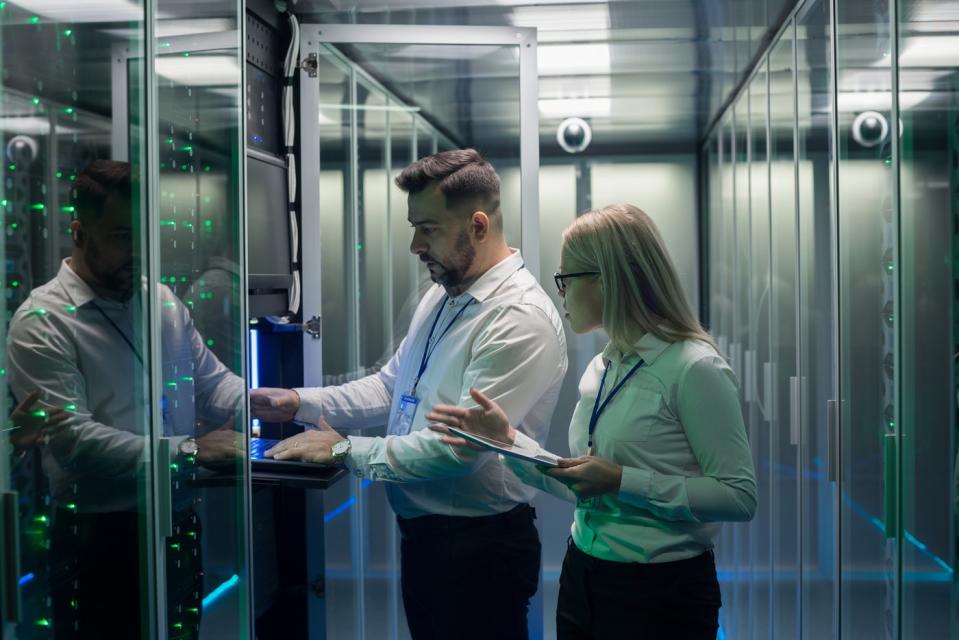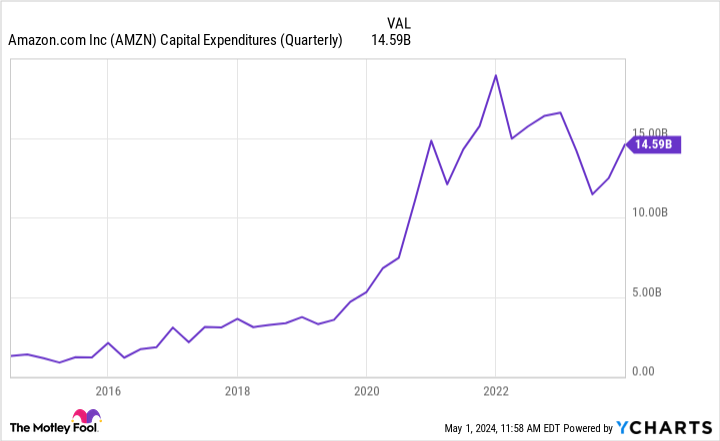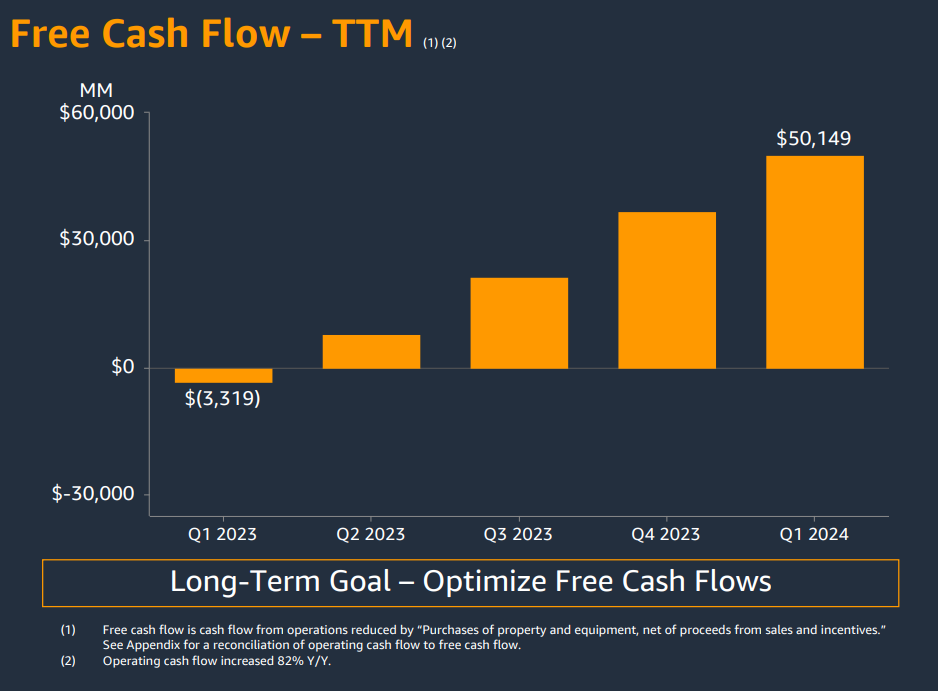There are many opportunities for investors when it comes to artificial intelligence (AI). Breakthroughs in accelerated computing and high-performance semiconductor chips are making impacts on myriad products and services.
In the background, one of the more lucrative opportunities benefiting from the booming AI demand is data centers. While Nvidia is the 800 pound gorilla in data center services, smart investors understand that there are many businesses competing alongside the chip giant.
One thing that might come as a surprise, however, is that not all data center investment prospects are traditional infrastructure and storage plays. In fact, one of Nvidia’s “Magnificent Seven” peers is getting in on the action.
Although Amazon (NASDAQ: AMZN) is best known for its e-commerce marketplace and cloud computing platform, the company recently announced that it’s planning an $11 billion investment to build data centers in Indiana.
Let’s break down why Amazon is interested in building its own data center infrastructure, and how these investments could lead to robust long-term gains in the future.
It started with Amazon’s $4 billion partnership
Last September, Amazon announced that it was investing $4 billion into an AI start-up called Anthropic. At the time of the announcement, Amazon poured $1.25 billion into Anthropic — with the additional $2.75 billion coming in late March.
The core thesis of the investment revolves around Amazon Web Services (AWS), the company’s cloud computing platform. The last couple of years have been challenging for the macroeconomy, as unusually high inflation and rising borrowing costs have significantly impacted both consumers and businesses. Enterprise software providers were not immune to these hiccups, and experienced decelerating sales growth.
One of the key aspects surrounding the deal was that Anthropic agreed to train future generative AI models on AWS. Moreover, Anthropic’s models are also being trained on Amazon’s in-house semiconductor chips Inferentia and Trainium.
While these details may have looked subtle at the time, Amazon’s latest move proves that the company isn’t messing around when it comes to building an AI behemoth — and Anthropic represents an important pillar in that roadmap.

Now, Amazon is doubling down
AWS is now a $100 billion revenue run-rate business. It’s clear that as AWS has become a more prominent feature of Amazon’s growth strategy, the company has invested significantly into cloud infrastructure — demonstrated by rising capital expenditure spend over the last 10 years.

These investments don’t appear to be slowing down, either. Amazon recently announced that it is planning an $11 billion investment for data centers in Indiana.
I see the ambitions in data centers as a mechanism to complement the Anthropic investment. Amazon is developing its own custom chips in an effort to migrate away from an overreliance on Nvidia’s graphics processing units.
Similar to how Amazon perfected warehouse efficiencies and shipping logistics by making hefty investments in fulfillment operations, Amazon appears to be mimicking this playbook as the company seeks to internalize as much of its AI roadmap as possible.
In the long run, I think these efforts will pay off in many different ways. Namely, Amazon can broaden its AI capabilities, which should unlock new growth opportunities for AWS. Furthermore, over time I suspect that building its own data centers and using its in-house chips will lead to cost saving.
Don’t worry, Amazon has heaps of cash
One thing that could be causing some trepidation are the price tags attached to these lofty AI goals. But don’t worry, Amazon has tons of cash.

For the trailing 12 months ended March 31, Amazon generated $50 billion in free cash flow. Moreover, at the end of the first quarter, the company held $84 billion of cash and equivalents on the balance sheet.
Amazon’s CEO Andy Jassy provided investors with assurance regarding the company’s planned infrastructure investments during the first-quarter earnings call as well. He stated:
The more demand AWS has, the more we have to procure new data centers, power and hardware. And as a reminder, we spend most of the capital upfront. But as you’ve seen over the last several years, we make that up in operating margin and free cash flow down the road as demand steadies out. And we don’t spend the capital without very clear signals that we can monetize it this way. We remain very bullish on AWS.
My interpretation of the above commentary is that Amazon will likely continue building out data centers in the future, so long as demand for AI warrants these investments. Considering that Jassy was CEO of AWS for 18 years before taking the reins over Amazon’s entire business, I’m optimistic about his outlook for the company’s growth in cloud and AI.
I find the investments in Anthropic, chips, and data centers to be extremely savvy and am bullish that these will all help ignite a new stage of growth for AWS.
Right now, Amazon trades at a 3.2 price-to-sales (P/S) ratio. This is essentially flat compared to the company’s 10-year average P/S. Investors with a long-term time horizon may want to consider scooping up shares of Amazon right now as the company’s AI journey is just beginning.
Should you invest $1,000 in Amazon right now?
Before you buy stock in Amazon, consider this:
The Motley Fool Stock Advisor analyst team just identified what they believe are the 10 best stocks for investors to buy now… and Amazon wasn’t one of them. The 10 stocks that made the cut could produce monster returns in the coming years.
Consider when Nvidia made this list on April 15, 2005… if you invested $1,000 at the time of our recommendation, you’d have $544,015!*
Stock Advisor provides investors with an easy-to-follow blueprint for success, including guidance on building a portfolio, regular updates from analysts, and two new stock picks each month. The Stock Advisor service has more than quadrupled the return of S&P 500 since 2002*.
See the 10 stocks »
*Stock Advisor returns as of May 6, 2024
John Mackey, former CEO of Whole Foods Market, an Amazon subsidiary, is a member of The Motley Fool’s board of directors. Adam Spatacco has positions in Amazon and Nvidia. The Motley Fool has positions in and recommends Amazon and Nvidia. The Motley Fool has a disclosure policy.
Forget Nvidia: This Other “Magnificent Seven” Member Just Poured $11 Billion Into Data Centers was originally published by The Motley Fool

